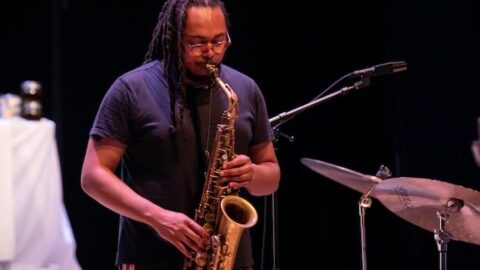BLUES BLOOD | BLACK FUTURE begins and ends with cooking. Sekai Abeni–one of four lyricists of the Roulette-commissioned piece–stirs greens, halves potatoes, and cuts carrots. She checks the heat and stirs to keep the food from sticking to the pan. It gently sizzles and pops as the musicians enter the stage.
The Immanuel Wilkins Quartet–Immanuel Wilkins (saxophone), Micah Thomas (piano), Daryl Johns (bass), and Kweku Sumbry (drums)–take their place in the bright light at the front of the stage. Vocalists Alyssa McDoom, Ganavya Doraiswamy, and Yaw Agyeman sit in a semi-circle, bathed in purplish blue light. Abeni continues to cook. The food sizzles and pops beneath the music. It sizzles and pops as the musicians exit and the livestream fades to black.

Abeni’s cooking is one of many components that reflect the cultural and political richness of Wilkins’ BLUES BLOOD | BLACK FUTURE, which premiered on Roulette’s website on March 27, 2021. The work is “based on the story of Daniel Hamm…a member of the Harlem Six, also known as the Blood Brothers–a group of children falsely accused and tried for murder in 1965.” In an interview, the young man shared how he was initially denied medical attention after being beaten by police; and how he had to prove the extent of his wounds: “I had to, like, open the bruise up and let some of the bruise blood come out to show them.”
This is not the first composition to feature Hamm’s words. Steve Reich’s Come Out (1966)–which was recently the subject of critical re-evaluation–repeats, layers, and phases Hamm’s statement. Like Reich, Wilkins leans into the creative potential of repetition, but for a radical, transformative process rooted in African American cultural pathways. Here, music is a tool to articulate strategies for a different future. Not a future where Black people continue to be synonymous with death as upheld by white supremacy, the wake of enslavement, and the criminal justice system. But a future where Black people’s vibrancy, creativity, and ordinariness are respected, accepted, and honored. Where their lives are truly recognized.
As Abeni brings seasonings and heat to enhance the flavor of the food; as Black people have utilized food and music to continue cultural practices and sustain justice work, Wilkins brings a range of instruments, techniques, tonalities, and timbres to create a piece that is meditative, focused, principled, and passionate.

BLUES BLOOD | BLACK FUTURE contains eleven sections with modal and experimental jazz tonalities. Wilkins, Abeni, McDoom, and Theaster Gates are the lyricists. At ~110 minutes with a sobering topic, stamina, focus, and dexterity are a must. Each and every musician delivered. Doraiswamy’s virtuosity was on full display in section four, moving from a Celtic mode to a raga-inspired section full of leaps, dynamic contrast, and lyrical declamation. McDoom’s effervescent voice opened the majority of the sections, weaving effortlessly as a leader and supporter. Agyeman drew upon a variety of techniques and timbres, from falsetto to spoken word to Nina Simone-esque declamation in section ten. Out of all the evocative lyrics, the following from section six is the most stark and infuriating in its applicability to the 1960s and the present day: “I had to crack open the bruises…Open the bruise up and let some of the Blues blood come out and show them.”
The Immanuel Wilkins Quartet’s energy, communication, and expressivity are nothing short of mesmerizing. Their heterogenous soundscape defined and responded to the character needed for each section. Sometimes they were an exuberant jazz quartet, playing for listeners in a dark, languid bar. Others times they were musical time travelers, using repetition to show how past, present, and future overlap, resonate, and define each other.

In the final section, Wilkins shows in no uncertain terms the symbolic, stylistic, and performance commonalities amongst spirituals, camp meetings, blues, and gospel. Yaw Agyeman, supported by Micah Thomas, sings “Oh Lord” in a sanctified holler. Repetition, syllabic elongation, thematic variation, and timbre extremes are utilized to make each statement of “Oh Lord” mean something different. Sometimes it is a cry for help. Sometimes it is a statement of exasperation. Other times, it is an expression of future possibilities. We will always be dreaming.
The premiere of BLUES BLOOD | BLACK FUTURE was exceptional; a success in every sense of the word. It must be programmed more. It must be recorded many times over. It is a miraculous and healing work.
I CARE IF YOU LISTEN is an editorially-independent program of the American Composers Forum, funded with generous donor and institutional support. Opinions expressed are solely those of the author and may not represent the views of ICIYL or ACF.
A gift to ACF helps support the work of ICIYL. For more on ACF, visit the “At ACF” section or composersforum.org.
























